Top Nine Birding Destinations in 2019
Wondering where to go birding in 2019? Check out our Latin American and Caribbean must-see destinations.
Whether you want to trek the Peruvian Andes in search of the Marvelous Spatuletail, explore Brazil's red sandstone canyons for a look at flocks of Lear's Macaw, or relax among Costa Rica's Scarlet Macaws, we've got the birding destination for you in 2019.
Our destination list — complied by ABC's international experts — is more than just an opportunity to see magnificent species. It's a chance to protect them. ABC works to save the most endangered birds in the Americas, and each of the destinations on our list was designed to do just that. Your visit helps provide the funds needed to make these reserves, and their bird conservation efforts, successful. Have a look at our list and start making your travel plans today!
NOTE: We've denoted birds' conservation status using the following International Union for Conservation of Nature (IUCN) Red List categories: Critically Endangered (CR), Endangered (EN), Vulnerable (VU), Near Threatened (NT), Least Concern (LC), and Data Deficient (DD).
1) El Dorado Reserve, Colombia
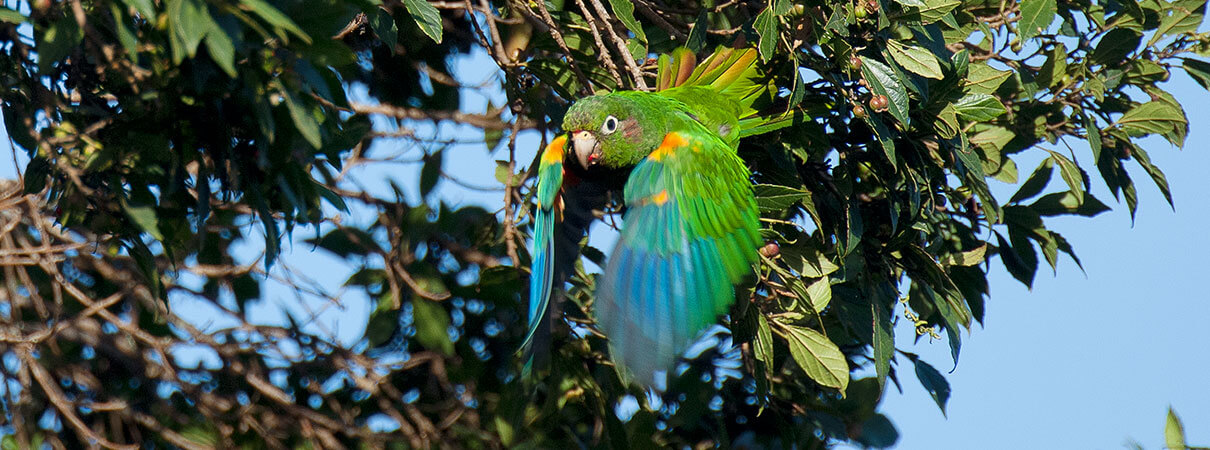
Santa Marta Parakeet. Photo by Murray Cooper
Overview: The El Dorado Reserve is the ideal birding destination in the Sierra Nevada de Santa Marta, a unique massif totally separated from the Andes, rising precipitously from the Caribbean beaches to 19,000 feet. This spectacular mountain range hosts the world's highest concentration of continental range-restricted bird species. The El Dorado Reserve protects 2,000+ acres of subtropical and montane cloud forest and is a two-hour drive from the popular tourist city of Santa Marta.
Birds: More than 360 species have been recorded, including the endemic Santa Marta Parakeet (EN), Santa Marta Blossomcrown (VU), Santa Marta Foliage-gleaner (NT), Santa Marta Tapaculo (LC), Santa Marta Antbird (NT), Santa Marta Wood-Wren (NT), Santa Marta Brushfinch (LC), and Santa Marta Screech-Owl, which often roosts and calls near the lodge. Most of the 21 Sierra Nevada endemics can be seen from the road and trails that meander up through this reserve's excellent forests. Feeders and gardens at the lodge attract a variety of hummingbirds, as well as habituated Black-fronted Wood-Quail (VU).
Amenities: The reserve is home to a comfortable lodge with dramatic mountain views that serves as a hub for several excellent birding trails. Also available for lodging are several recently built “Kogi” huts, modeled after local indigenous homes.
Support: ABC helped its partner ProAves to purchase 2,211 acres at El Dorado Reserve between 2006 and 2015, as well as supporting reserve staff, the development of tourism, lodge construction, and reforestation of degraded lands at the reserve.
Insider Tips: Take an early morning drive up to the highest part of the reserve to take in spectacular, contrasting views of the towering glacier-covered peaks of the Sierra Nevada and Caribbean beaches below. Here is also the world's core breeding population of the Santa Marta Parakeet (EN), and first light provides the best opportunity to see this species.
Learn more about visiting El Dorado.
2) Buenaventura Reserve, Ecuador
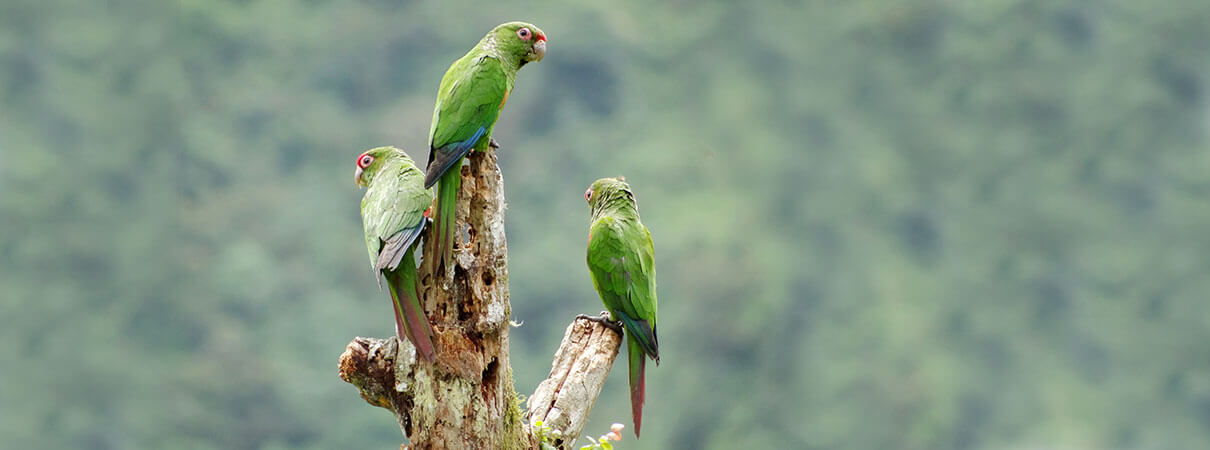
El Oro Parakeet. Photo by Francisco Sornoza/Fundación Jocotoco
Overview: Now spanning 6,546 acres, Buenaventura Reserve is located in El Oro province in southern Ecuador, an area considered one of the best birding destinations in Ecuador – and one of the most accessible, too. The reserve protects a narrow zone of tropical forest on the otherwise dry west slope of the Andes. Due in part to its range in altitude, the reserve protects a wide variety of bird habitats ranging from dry Tumbezian forests to moist cloud forests.
Birds: All told, 330 bird species have been recorded, many of which are range-restricted, including the endemic El Oro Parakeet (only discovered in 1980)(EN), Ecuadorian Tapaculo (EN), Club-winged Manakin (LC), Gray-backed Hawk (EN), Rufous-headed Chachalaca (VU), Pacific Royal Flycatcher (VU), Pacific Tuftedcheek (LC), Long-wattled Umbrellabird (VU), Golden-winged Manakin (LC), and Ochraceous Attila (VU).
Amenities: Umbrellabird Lodge, which includes five cabins and a dining room, plus a trail network.
Support: Buenaventura was established in 1999 by the Ecuadorian conservation group Jocotoco Foundation to preserve remaining habitats, particularly for range-restricted birds. The reserve has been expanded several times since then, frequently with support from ABC. In 2018, ABC helped Jocotoco create a volunteer-tourism program, which allows international visitors to help out at this and other Jocotoco reserves.
Insider Tips: You haven't lived until you see an umbrellabird! The best time to see the Long-wattled Umbrellabird is from November to April in the late afternoon, (4 p.m. is optimum); ask a guard to accompany you. You could spend an entire day at the dining hall's amazingly busy hummingbird feeders, while also enjoying the resident coati family. For another hummingbird spectacle, check out the nearby hummingbird garden, set up in 2017 with ABC support.
Learn more about visiting Buenaventura.
3) Canudos Biological Station, Brazil

Lear's Macaw. Photo by Ciro Ginez Albano
Overview: The Canudos Biological Station, located in Brazil's Bahia Department, is a pioneering initiative managed by Biodiversitas Foundation that protects one of the planet's most endangered and admired birds, the Lear's Macaw (EN). Thanks to focused conservation efforts, the species' numbers have increased from a few dozen in the late 1980s to approximately 1,700 today. The 3,274-acre reserve is striking: Its sandstone canyons are weathered into odd forms, cloaked in Caatinga habitat with giant cacti and unique flora, including the Licuri Palm, an important food for the macaw.
Birds: In addition to the Lear's Macaw, you are likely to see other northeastern Brazil endemics, including the Broad-tipped Hermit (LC), Red-shouldered Spinetail (LC), and Cactus Parakeet (LC). Also, watch for the Black-bellied Antwren (LC), Barred Antshrike (LC), Red-legged Seriema (LC), and Blue-winged Macaw (NT), among others. In the evenings, a guide-led night walk might reveal the Rufous Nightjar (LC) and several owl species.
Amenities: Basic accommodations at the Canudos Biological Station, where there are a accommodations and a dining room.
Support: ABC helped Biodiversitas purchase nine tracts of land totaling 3,274 acres, which comprise the entire reserve. ABC also provided Biodiversitas with support to manage the reserve and build tourism infrastructure.
Insider Tips: To see the Lear's Macaw, go during the breeding season (March to May) and be prepared to rise before dawn. Guides at the reserve, employed from the local community, will lead you to see flocks of these large, noisy, dazzling blue birds as they flap past the dramatic red sandstone canyons where they roost and nest.
Learn more about visiting Canudos.
4) Osa Verde Lodge, Costa Rica

Scarlet Macaw. Photo by Warren Cooke
Overview: On Costa Rica's southern Pacific coast, Osa Verde Lodge is a luxurious birding destination to see endemic birds like the Black-cheeked Ant-Tanager (EN), giant trees among the Osa peninsula's old-growth tropical rainforest, and the perfect place to witness hatchling sea turtles enter the ocean on the wild Piro Beach.
Birds: The Osa bird list includes more than 460 species, including many regional endemics such as the Mangrove Hummingbird (EN), Yellow-billed Cotinga (EN), and Turquoise Cotinga (VU). The Osa also boasts perhaps the healthiest population of Scarlet Macaws (LC) in Central America, and Great Curassows (VU) are recovering well here from past hunting pressure.
Amenities: Osa Conservation offers access for day visitors and several options for overnight guests, particularly the Osa Verde Lodge on the south side of the Osa peninsula.
Support: Osa Conservation is a local conservation organization working to protect a variety of rich ecosystems, and their properties offer birders not only fantastic wildlife viewing but also the opportunity to provide direct support for their conservation programs. American Bird Conservancy worked with Osa Conservation to purchase 1,679 acres near Osa Verde Lodge and 29 acres to establish the Yellow-billed Cotinga Reserve, in addition to supporting bird monitoring and tracking projects.
Insider Tips: June to November is the rainy season. Sea turtle nesting occurs all year, but at Osa Verde January to April is best to see Green Turtles.
Learn more about visiting Osa Verde.
5) Barba Azul Nature Reserve, Bolivia
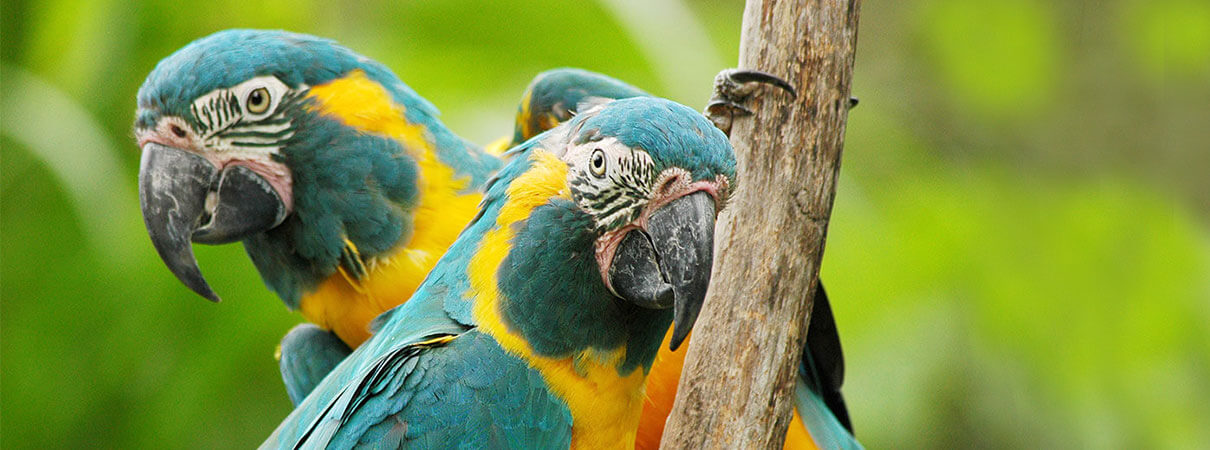
Blue-throated Macaws. Photo by Mark R. Layman/ShutterStock
Overview: This reserve is managed by Asociación Armonía and spans more than 26,000 acres of seasonally flooded savanna with palm forest islands in northeastern Bolivia. Barba Azul is the only well-protected savanna in Bolivia's Beni region, with remarkable numbers of Blue-throated Macaws (CR), threatened grassland bird species, and mammals.
Birds: The Critically Endangered Blue-throated Macaw, with a total wild population of approximately 450 birds, is the reserve's star attraction, sharing the property with many other birds, including the globally threatened Cock-tailed and Sharp-tailed Tyrants (VU), and Black-masked Finch (VU). Other birds include the ostrich-like Greater Rhea (NT), Orinoco Goose (NT), Nacunda Nighthawk (LC), and Southern Screamer (LC).
Other Wildlife: The strict conservation practices in the reserve have made this site a top destination for mammal watchers. Visitors frequently see Giant Anteater (VU) and Maned Wolf (NT). The protected tall grass supports increased numbers of Pampas Deer (NT), Marsh Deer (VU), Puma (LC), and Collared Peccary (LC).
Amenities: Barba Azul Nature Reserve has four cabins, with twin beds and private bathrooms, and a new dining hall, built with support from ABC. Chartered flights are recommended and can be purchased from Trinidad, the capital city of Beni Department. Getting to this birding destination by vehicle is very difficult and only possible in the dry season, between June and Sept. Armonía requires at least a three-night stay.
Support: ABC funded our partner Armonía to conduct surveys that discovered the largest known concentration of Blue-throated Macaws in this area, and followed up on this research by helping Armonía purchase three tracts of land totaling 26,459 acres. ABC also helped Armonía construct reserve infrastructure for staff, researchers, and tourists; experiment with macaw nest boxes on the reserve; and improve reserve management.
Insider Tips: You will disconnect from the outside world at this remote reserve – especially because there is no internet or cell coverage — but you will surely re-connect with nature. Go between March and October to ensure that you will see the Blue-throated Macaws, which “disappear” each breeding season to breed elsewhere in the vast Beni Savanna.
This is a great place to see and photograph wildlife because it is an open savanna. At any time of year, though, don't forget your boots and mosquito repellent. An excellent field guide, Birds of Bolivia, was published by Armonía and will soon be available in the United States.
Learn more about visiting Barba Azul.
6) Holywell Recreation Area, Jamaica
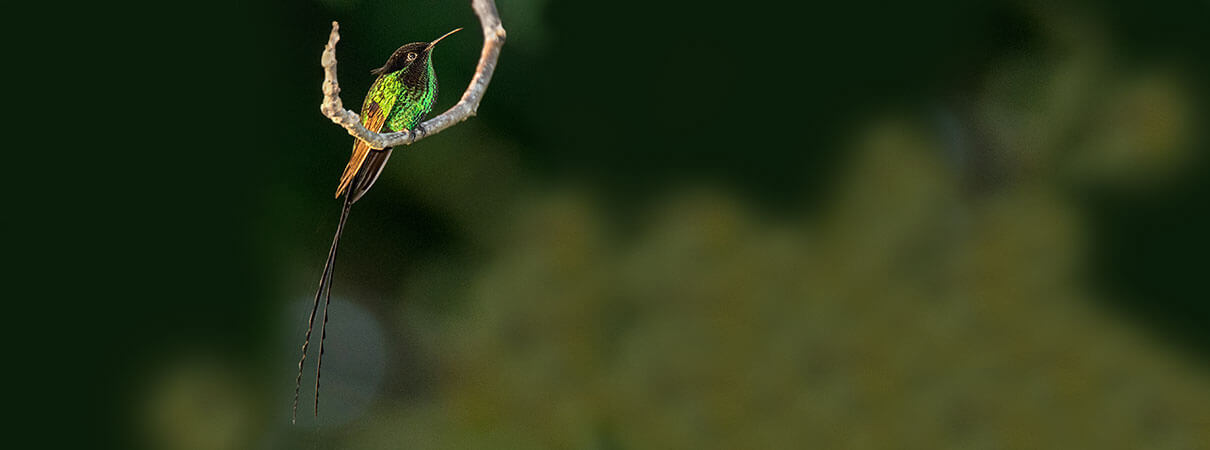
Streamertail. Photo by Owen Deutsch
Overview: Also known as the “Hardwar Gap” area, Holywell Recreation Site is managed by the Jamaica Conservation & Development Trust (JCDT) and is part of Jamaica's Blue and John Crow National Park. The park was designated a UNESCO World Heritage site in 2015. Holywell is a lush, mist-shrouded montane forest located an hour's drive from the capital, Kingston.
Birds: This is an ideal birding destination to see endemic Jamaican birds, including the Jamaican Tody (LC), Jamaican Woodpecker (LC), Jamaican Pewee (LC), Sad Flycatcher (LC), Jamaican Becard (LC), Blue Mountain (NT) and Jamaican Vireos (LC), Jamaican Euphonia (LC), Jamaican Spindalis (LC), Jamaican Oriole (LC), Jamaican Lizard-Cuckoo (LC), Jamaican Mango (LC), Jamaican Owl (LC), Jamaican Blackbird (EN), and the spectacular Black-billed Streamertail (LC). Wintering migrants include abundant warblers.
Other Wildlife: Giant Swallowtail butterfly and Jamaican Boa (VU).
Amenities: This site has three cabins available for rent, nine miles of hiking trails, picnic sites, and camping spots (with tents for rent). Cabins at Holywell are booked months in advance for weekends. There is no food service at night, so you have to bring your own meals. Guards are friendly and knowledgeable about birds. Staying nearby at Mt. Edge Guest House is another option that is well-known for locally sourced food and has feeders where one can easily see streamertails.
Support: ABC has worked with our partner the JCDT to improve tourism infrastructure at Holywell and Portland Gap, and to conduct reforestation, migratory bird monitoring, and agroforestry workshops.
Insider Tips: Visit during the week to avoid Kingston crowds that visit on weekends and holidays. Contact JCDT in advance to book a birding walk. This is an epic place to see many of the Jamaican endemics. If you are feeling especially adventurous, arrange a trip with JCDT to hike the Blue Mountain Peak.
Learn more about visiting Holywell.
7) Serra do Urubu, Brazil

Seven-colored Tanager. Photo by Ciro Albano
Overview: Serra do Urubu, in the Brazilian state of Pernambuco, is considered one of the most important forests for bird conservation in the Neotropics. Serra do Urubu includes two reserves that together span 2,471 acres, encompassing the only remaining premontane Atlantic Forest in this state.
Birds: The reserve is home to 14 globally threatened bird species and 250 bird species in total. These include the Seven-colored Tanager (VU), Long-tailed Woodnymph (EN), Pinto's Spinetail (EN), Orange-bellied Antwren (CR), White-collared Kite (EN), and Alagoas Tyrannulet (CR).
Amenities: In addition to the popular self-guiding trail and other guide-led trails, the reserve's newest feature is a hummingbird garden, where visitors can see up to 20 hummingbird species. The garden has native plant landscaping, supplemented by hummingbird and fruit feeders. A comfortable, covered pavilion allows for a relaxing place to set up photography equipment and take some amazing photos. Visitors can reserve the single rustic room at the guard station. If reserved beforehand, breakfast and lunch is available. By the end of 2019, Serra do Urubu will feature an observation tower situated in the middle of the forest.
Support: The reserve was established in 2004 by Brazilian conservation group SAVE Brasil, which has been diligently working to expand it and to create tourism infrastructure for visitors to enjoy. ABC has worked with SAVE Brasil to expand this reserve and support its management, helping to make it an outstanding birding destination.
Insider Tip: The rainy season is from May to October, with rains heaviest from June to August. Access might be complicated or delayed by heavy rain. From September to April, there is less precipitation and the area is more accessible. Many visitors stroll the 1.5-mile interpretative forest trail, an easy walking path that on average takes two hours, but there are other trails that can be visited with a local guide.
Learn more about visiting Serra do Urubu.
8) Tapichalaca Reserve, Ecuador
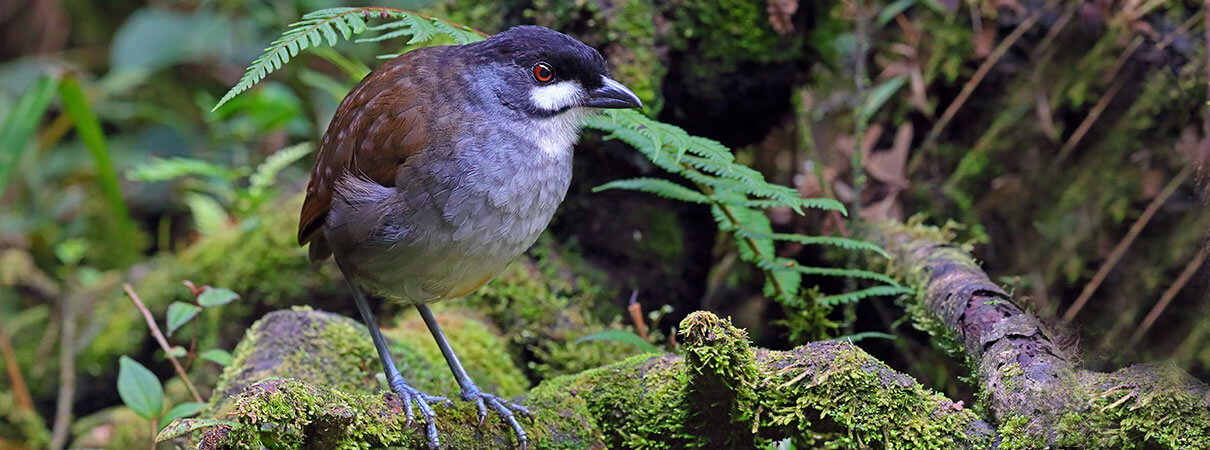
Jocotoco Antpitta. Photo by Greg Homel/Natural Elements Productions
Overview: Tapichalaca is situated just across the Continental Divide on the Andes' east (or Amazonian) slope and is part of a significant conservation corridor in southern Ecuador. This 12,350-acre cloud forest reserve ranges in altitude from 6,500 to 11,000 feet. Over 16 feet of rain falls annually in this zone, compared to a typical 6.5 feet in Ecuador's lowland Amazon forest.
Birds: This is the only place in the world where birders can expect to see the Jocotoco Antpitta (EN). Other rare, range-restricted species include the Bearded Guan (NT), Golden-plumed Parakeet (VU), White-breasted Parakeet (VU) and Spot-winged Parrotlet (VU). Additional birds of interest include the Rufous-capped Thornbill (LC), Masked Saltator (NT), Ocellated Tapaculo (LC), Coppery-chested Jacamar (VU), and the Masked Mountain-Tanager (VU).
Other Wildlife: The reserve is part of an important corridor for populations of Andean Tapir (EN), Spectacled Bear (VU), Puma (LC), Andean Paca (NT), Red Brocket Deer, and Andean Coati (LC).
Amenities: Casa Simpson Lodge sits a short hike from trails leading to antpittas and parakeets, and mixed feeding flocks, including many tanagers.
Support: The Jocotoco Antpitta's 1997 discovery by Latin America bird expert Robert S. Ridgely and his colleagues – inside what is now the reserve – sparked not only the reserve's creation, but also the establishment of ABC's Ecuadorian partner, the Jocotoco Foundation, which now administers 12 reserves around the country. ABC worked with Jocotoco Foundation to purchase 2,754 of the reserve's 8,305 acres, and has also supported tourism, management, parakeet nest boxes, and reforestation on degraded lands at this reserve.
Insider Tips: You'll be lucky if it doesn't rain, so don't forget your rain gear. But what's a little moisture when you're communing with the Jocotoco Antpitta? Each morning, the antpitta reveals itself, hopping into view from the dense foliage to snap up worms placed on the ground by a guard.
Learn more about visiting Tapichalaca.
9. Abra Patricia Reserve, Peru
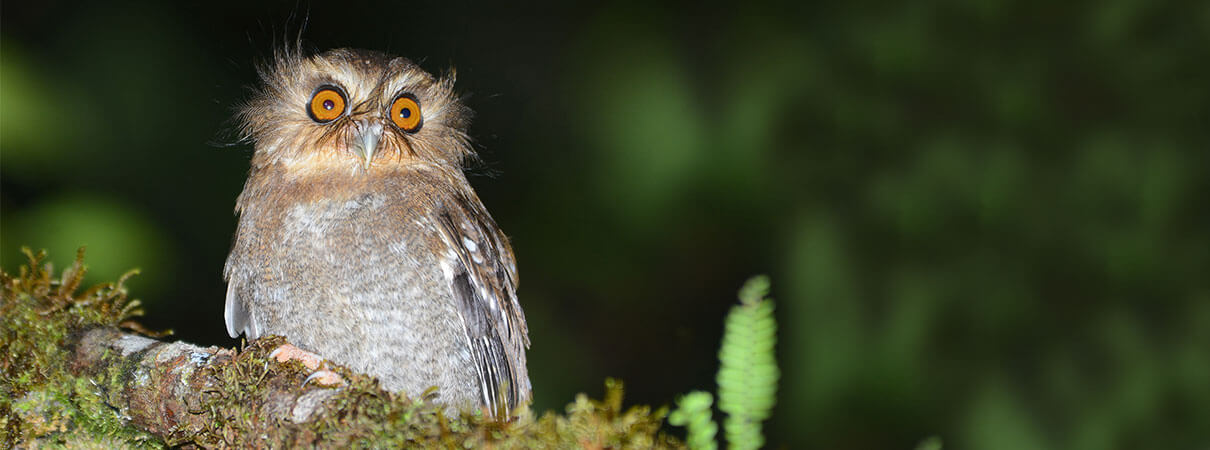
Long-whiskered Owlet. Photo by Alan Van Norman
Overview: Known simply as Abra Patricia Reserve, the Abra Patricia-Alto Nieva Private Conservation Area and Conservation Concession spans close to 25,000 acres of cloud forest in the Peruvian Department of Amazonas. The reserve is managed by the Peruvian conservation organization Asociación Ecosistemas Andinos (ECOAN).
Birds: The area's bird list includes more than 300 species, many of them Peru endemics. A total of 23 bird species recorded here are considered globally threatened, including the Long-whiskered Owlet (EN) and Ochre-fronted Antpitta (EN).
Amenities: Owlet Lodge at Abra Patricia features a dining hall, cabins, miles of trails, a canopy tower, fruit and hummingbird feeders, and a feeding station where habituated antpittas come for worms. It is the perfect base for several days' birding.
Support: ABC worked with ECOAN to establish this reserve in 2005, develop its tourism infrastructure, reforest degraded areas, and to expand its borders. Tourism profits are reinvested by ECOAN into reserve management and conservation projects.
Insider Tips: Bring a warm fleece and raingear, as the climate tends to be cool and wet. If you are already visiting this reserve, consider making a side trip to Huembo Reserve to experience the Marvelous Spatuletail (EN), one of the world's most spectacular and localized hummingbirds.
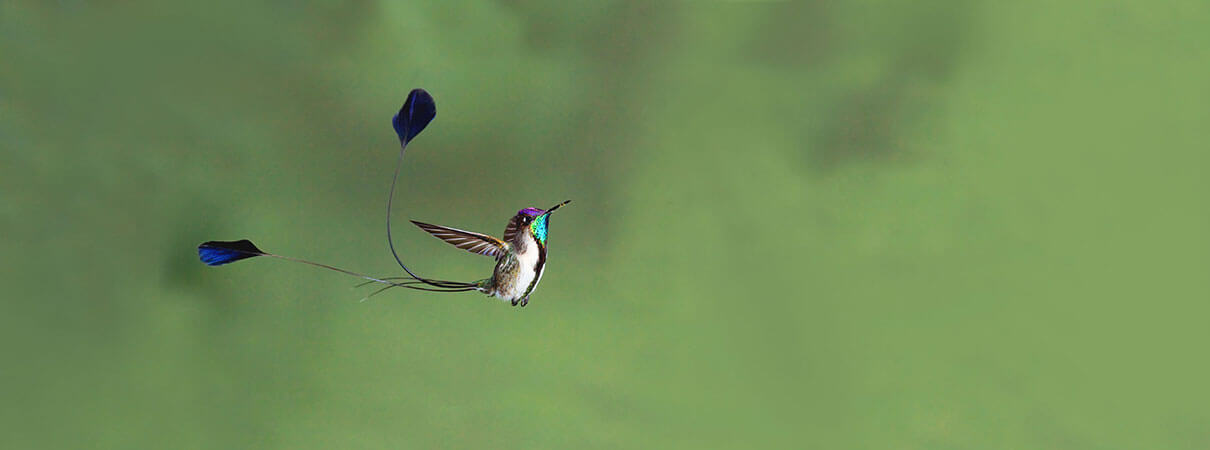
Marvelous Spatuletail. Photo by Dubi Shapiro
Learn more about visiting Abra Patricia.
Looking for more birding ideas in 2019? Visit American Bird Conservancy's newly redesigned Conservation Birding website, where you can explore our entire network of partner reserves and associated birding routes – all of which benefit bird conservation. To learn more about our conservation work in Latin America and the Caribbean, visit our International program page.


















































